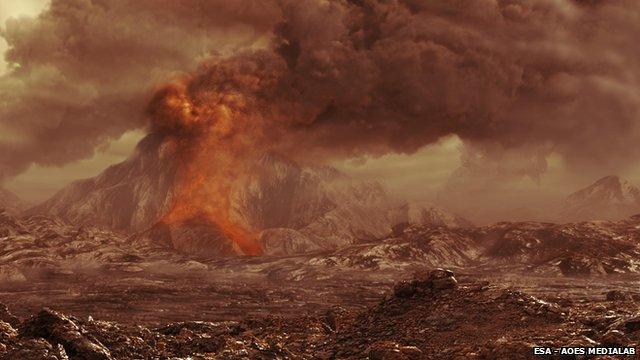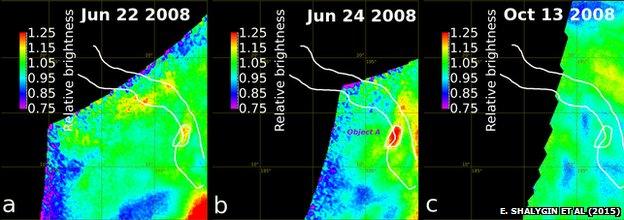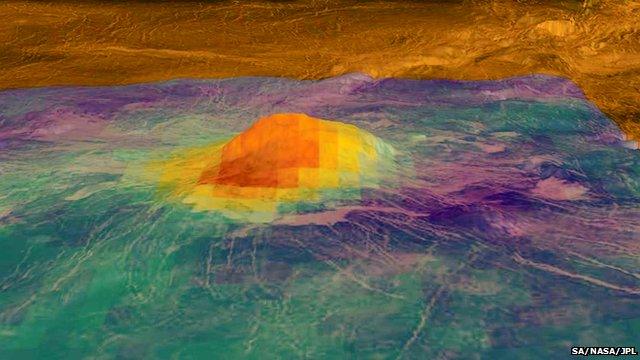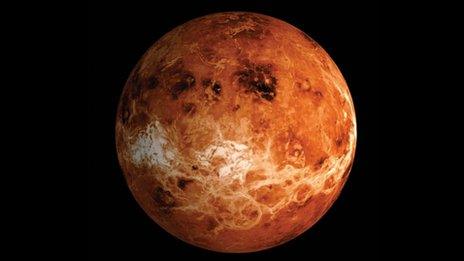'Tantalising' glimpse of volcanic eruptions on Venus
- Published

Artist's impression: There is evidence for a variety of volcanic activity on Venus
Scientists say they have the best evidence yet that there is hot lava spewing from the surface of Venus.
The planet was known to have an active volcanic history but this is the best evidence yet for ongoing eruptions.
Four "hotspots" in a rift region of the planet's northern hemisphere were seen to rise and fall dramatically in temperature over several days in 2008, suggesting an active lava flow.
The observations were collected by the Venus Express probe.
Lines of evidence
This European Space Agency mission arrived at the planet in 2006 and its findings had already hinted in 2010, external that Venus might still be volcanically active.
That evidence was compiled from infrared measurements, because the planet's surface is shrouded by a thick and swirling atmosphere. A distinct dark region towards the planet's south pole suggested lava deposits that were less than 2.5 million years old.
Then in 2012 Venus Express researchers reported a spike in the sulphur dioxide content of the Venusian atmosphere, which happened in 2006-7 and declined gradually afterwards. This was very evocative of a blast of volcanic activity, but could also have been a result of shifting winds.
Now, images in near-infrared wavelengths snapped by the craft's Venus Monitoring Camera have revealed tell-tale, transient hotspots in a region called Ganiki Chasma.
"This latest evidence very much leads us to believe that we've finally found proof that the surface is tectonically active and changing today," said Dr Colin Wilson, an atmospheric physicist at Oxford University and the science operations coordinator for Venus Express.
The pictures were first unveiled, external at a conference in March 2014 but have now been analysed in detail and published in the journal Geophysical Research Letters, external.

The hotsposts appeared and faded in near-infrared images from 2008
"We have now seen several events where a spot on the surface suddenly gets much hotter, and then cools down again," said Dr Eugene Shalygin, the publication's lead author, from the Max Planck Institute for Solar System Research in Germany.
"These four hotspots are located in what are known from radar imagery to be tectonic rift zones, but this is the first time we have detected that they are hot and changing in temperature from day to day. It is the most tantalising evidence yet for active volcanism."
Volcanic variety
The hot areas could indicate a pool of lava, superheated rocks or even plumes of gas surging from beneath the surface. A combination of these scenarios is probably most likely, Dr Wilson said.
"The region is a rift system on the flanks of a volcano," he told BBC News. "These rifts are formed when, for example, a magma chamber lying below fills up and causes expansion and fracture up above.
"We don't really know exactly what's happening, because the spatial resolution of the images we're getting is blurred by the overlying clouds, to 50-100km pixel size."

Results from 2010 suggested relatively young lava deposits (indicated in red) towards Venus's south pole
Radar data from previous missions revealed many volcanic peaks on Venus, most of which have shallow slopes, "like Hawaii", Dr Wilson explained.
"That implies fairly liquid, low-viscosity magma flowing down their sides."
But there are also signs that some Venusian volcanoes were rather more explosive.
"It seems that on Venus, as on Earth, we can have a variety of styles of volcanism," Dr Wilson said.
Future Venus orbiter missions will reveal more detail about Venus and its intriguing, apparently active geology - including just how similar it is to Earth's.
The successful eight-year career of Venus Express, however, ended when the craft ran out of fuel, external in November 2014. The orbiter plunged into the planet's hot, carbon-laden atmosphere in January.
Follow Jonathan on Twitter, external
- Published7 October 2011
